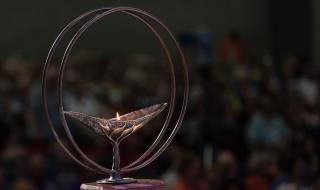Advertisement
As many congregations celebrate ingathering and the start of a new year, I am reflecting on the ways that we experience cracks or breaks within covenantal community. As painful as they are, we need not despair. As songwriter Leonard Cohen writes, “There is a crack in everything. That’s how the light gets in.”
The metaphor of light is important in Unitarian Universalism. The act of lighting the chalice is a ritual. The flame is a symbol of truth and justice, of the inherent worth and dignity of every person. It is a beacon to guide our way.
But our chalice is actually a combination of two symbols—the flame and the cup. The cup is a symbol of care and sustenance, the nourishment we offer each other in religious community. The cup is what holds the light, it’s where the flame is tended, it’s what we create when we reach out to each other in covenant.
The cup is also what can break. We need to remember that the cup needs our attention, too, for it is easy to hold up a light and declare that everyone is welcome. It is harder to build a place where everyone is truly at home.
Throughout much of our history, but very explicitly since 1997, Unitarian Universalists have extolled the importance of antiracism work and multiculturalism, and yes, we have also been divided by this work. At this summer’s General Assembly, I was able to share that today we have by far the most racially and gender diverse leadership team at the UUA, on the Board, and among our ministry and religious professionals in our history. This is incredibly important, but it doesn’t mean we are done. In fact, now is the more difficult part. Because real inclusion means that the UUA not only looks different, it feels different, and we lead differently. It is powerful, creative, painful, and messy at times, exciting and demanding, full of learning and grace. Most of all, it is hopeful, inspiring, and faithful. And it is my deep honor to serve our faith in this time of transition that is both challenging and so very precious.
One of my favorite stories comes from Jacob ben Wolf Kranz, a Jewish preacher of the eighteenth century. I’ve heard it told many ways, but it always begins with a beautiful diamond. In one telling, this diamond is so stunning that a town keeps it on display so that all can enjoy it. One day, though, the townspeople awake to find a long deep crack running through it. Shocked and heartbroken, they ask every jeweler they know, but each one says it cannot be fixed. To try would risk breaking it into several pieces.
Then a stranger comes to town and says they can fix it. The people are wary, but their hope at having their treasure restored outweighs their fear. They give the diamond to the stranger. Two weeks later, the stranger returns. When the people see the diamond, they are amazed. Rather than polishing away the crack, the stranger carved a beautiful rose into its face, using the crack as part of the rose’s stem. The people exclaim, “You have taken something that was cracked and broken and made it even more beautiful than before!”
The story reminds us that neither perfection nor brokenness is the end of the story. When the stranger looks at the diamond, they don’t just see the flaw. They see in the brokenness the potential of the rose.
The townspeople took a risk in trusting the stranger with the diamond. Risk is required for the rose. What we are signing up to do as UUs is no easy task: to follow the liberating and inclusive principles and spirit of our tradition to build a community with a marginless center, a cup to nurture a love that acts as a force for justice within our lives, our congregations, and our movement as a whole.
It is this transformative love that makes the future for Unitarian Universalism irresistible. What would it look like to bring not just our shared interests and intellects, but our boldness and brokenness, our vibrancy and our vulnerability? Where we worship in ways that name fearlessly the conditions of our lives and the possibility in the beauty and love that is within us all. A future where not only is everyone welcome but everyone is at home.
This is the community, the work, and the religion I want to be a part of. Somewhere beyond perfection and brokenness, love helps us build a cup to hold us all, a rose we carve together. It is this love that lives in the fullness of our tradition and that can unlock the fullness of our future.
